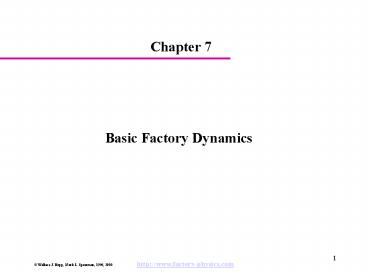Basic Factory Dynamics PowerPoint PPT Presentation
1 / 21
Title: Basic Factory Dynamics
1
Chapter 7
- Basic Factory Dynamics
2
Definitions
- Workstations a collection of one or more
identical machines. - Parts a component, sub-assembly, or an assembly
that moves through the workstations. - End Items parts sold directly to customers
relationship to constituent parts defined in bill
of material. - Consumables bits, chemicals, gasses, etc., used
in process but do not become part of the product
that is sold. - Routing sequence of workstations needed to make
a part. - Order request from customer.
- Job transfer quantity on the line.
3
Definitions (cont.)
- Throughput (TH) for a line, throughput is the
average quantity of good (non-defective) parts
produced per unit time. - Work in Process (WIP) inventory between the
start and endpoints of a product routing. - Raw Material Inventory (RMI) material stocked at
beginning of routing. - Crib and Finished Goods Inventory (FGI) crib
inventory is material held in a stockpoint at the
end of a routing FGI is material held in
inventory prior to shipping to the customer. - Cycle Time (CT) time between release of the job
at the beginning of the routing until it reaches
an inventory point at the end of the routing.
4
Factory Physics
- Definition A manufacturing system is a
goal-oriented network of processes through which
parts flow. - Structure Plant is made up of routings (lines),
which in turn are made up of processes. - Focus Factory Physics is concerned with the
network and flows at the routing (line) level.
5
Parameters
- Descriptors of a Line
- 1) Bottleneck Rate (rb) Rate (parts/unit
time or jobs/unit time) of the process center
having the highest long-term utilization. - 2) Raw Process Time (T0) Sum of the
long-term average process times of each station
in the line.
6
Parameters (cont.)
- Relationship
- Critical WIP (W0) WIP level in which a line
having no congestion would achieve maximum
throughput (i.e., rb) with minimum cycle time
(i.e., T0). - W0 rb T0
7
A Manufacturing Law
- Little's Law The fundamental relation between
WIP, CT, and TH over the long-term is - Insights
- Fundamental relationship
- Simple units transformation
- Definition of cycle time (CT WIP/TH)
8
Penny Fab One
- Review Examples in Text
9
Best Case Performance
- Best Case Law The minimum cycle time (CTbest)
for a given WIP level, w, is given by - The maximum throughput (THbest) for a given WIP
level, w is given by,
10
Best Case Performance
- Example For Penny Fab, rb 0.5 and T0 8, so
W0 0.5 ? 8 4,
11
Worst Case Performance
- Worst Case Law The worst case cycle time for a
given WIP level, w, is given by, - CTworst w T0
- The worst case throughput for a given WIP level,
w, is given by, - THworst 1 / T0
12
TH vs. WIP Worst Case
Best Case
rb
Worst Case
1/T0
W0
13
CT vs. WIP Worst Case
Worst Case
Best Case
T0
W0
14
Practical Worst Case
- Observation There is a BIG GAP between the Best
Case and Worst Case performance. - Question Can we find an intermediate case that
- divides good and bad lines, and
- is computable?
15
Practical Worst Case Performance
- Practical Worst Case Definition The practical
worst case (PWC) cycle time for a given WIP
level, w, is given by, - The PWC throughput for a given WIP level, w, is
given by, - where W0 is the critical WIP.
16
TH vs. WIP Practical Worst Case
Best Case
rb
PWC
Good (lean)
Worst Case
Bad (fat)
1/T0
W0
17
CT vs. WIP Practical Worst Case
Worst Case
PWC
Bad (fat)
Best Case
Good
(lean)
T0
W0
18
Penny Fab Two Performance
Best Case
rb
Penny Fab 2
Practical Worst Case
1/T0
Worst Case
W0
19
Penny Fab Two Performance (cont.)
Worst Case
Practical Worst Case
Penny Fab 2
1/rb
T0
Best Case
W0
20
Take-Aways
- Key points
- Littles Law, although not always exact can be
used to approximate a single workstation, line or
entire plant - When there is a bottleneck the WIP THR at
bottleneck (rb) times To CT for entire flow - Critical Wip number of machines in system
this is ALWAYS the case for a balanced line all
machines have same output rate no wip buildup - Single machine or balanced line the capacity
is the reciprocal of the CT ie CT 2 hours
Capacity ½ piece per hour - Station capacity can be calculated by
machines/Process time for both balanced and
unbalanced
21
Factory Dynamics
- Performance Measures
- throughput
- WIP
- cycle time
- service
- Range of Cases
- best case
- practical worst case
- worst case
- Diagnostics
- simple assessment based on rb, T0, actual
WIP,actual TH - evaluate relative to practical worst case

